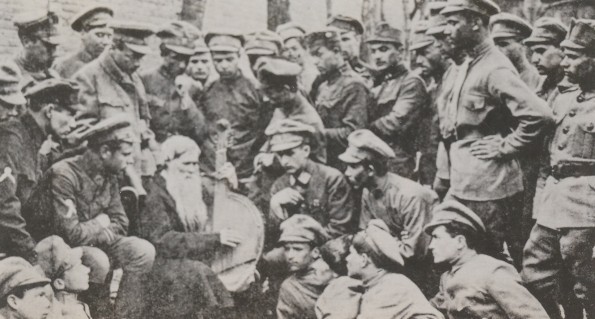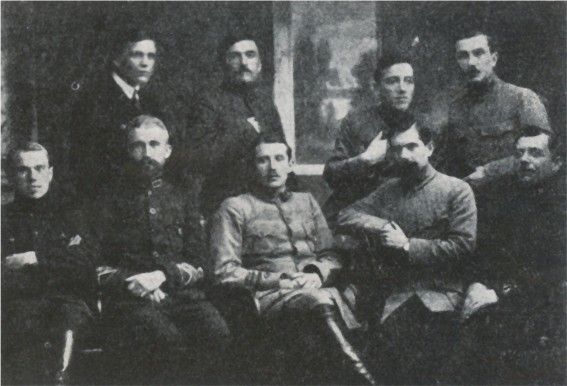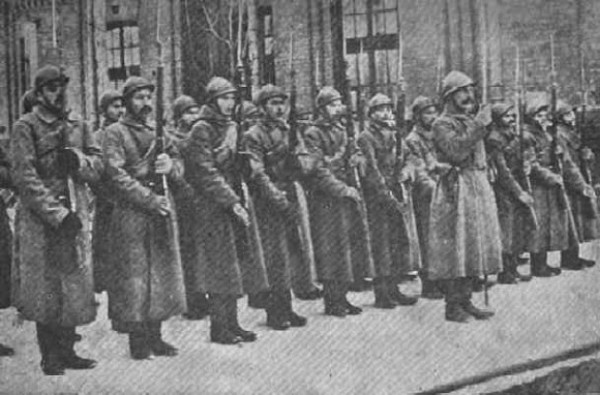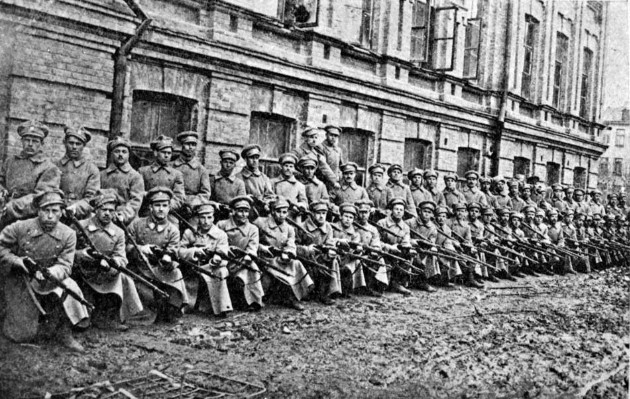Sich Riflemen
Sich Riflemen (Січові Стрільці, Київські Січові Стрільці [КСС]; Sichovi Striltsi, Kyivski Sichovi Striltsi [KSS]). A leading regular unit of the Army of the Ukrainian National Republic which operated from 1917 to 1919 under different organizational forms: as the Galician-Bukovynian Batallion of Sich Riflemen, the First Kurin of Sich Riflemen, the Regiment of Sich Riflemen, the Separate Detachment of Sich Riflemen, the Division of Sich Riflemen, the Siege Corps of Sich Riflemen, the Corps of Sich Riflemen, and the Group of Sich Riflemen. The core of its name was derived from the Ukrainian Sich Riflemen in Galicia.
The Galician-Bukovynian Batallion of the KSS was established in Kyiv on 13 November 1917 by the Galician-Bukovynian Committee. Its first recruits were former soldiers of the Austro-Hungarian army who had escaped from Russian prisoner of war camps and come to Kyiv to participate in the building of a Ukrainian state. By the end of January 1918 the kurin had about 500 men organized in three companies, commanded by Capts Roman Sushko, Ivan Chmola, and Vasyl Kuchabsky. Under Col Yevhen Konovalets’s command it defended Kyiv against a Bolshevik insurrection and, later, the invading Bolshevik forces, and then secured the UNR government's retreat to Zhytomyr. After recapturing Kyiv on 1 March 1918, the First Kurin of the KSS was assigned the task of guarding government institutions and preserving public order in the city. It expanded into the Regiment of KSS, consisting of two infantry kurins and a reserve kurin, a cavalry recognizance unit, and an artillery battery. A third of its approximately 3,000 men were from the Dnipro River region of Ukraine.
When Hetman Pavlo Skoropadsky came to power on 29 April 1918, the KSS declined to serve under him and were disarmed by German troops. The regiment's soldiers joined other military or militia units. Many of them transferred to the Second Zaporozhian Regiment (commanded by Petro Bolbochan), where they formed the Third Kurin under Roman Sushko's command. With the hetman's consent to a partial regrouping of the KSS, the Separate Detachment of Sich Riflemen was formed at the end of August 1918 in Bila Tserkva. Its approx 1,200 men were divided into an infantry regiment consisting of a machine-gun company, a reconnaissance troop, an artillery battery, and a technical unit. The detachment played a key role in overthrowing the Hetman: it began the revolt in Bila Tserkva and scored a decisive victory over his guard on 18 November at Motovylivka. During the siege of Kyiv the detachment grew into the Division of KSS (11,000 men) and in early December into the Siege Corps of Sich Riflemen (approx 25,000 men) by incorporating two Dnipro and the Black Sea divisions. After taking Kyiv on 14–15 December 1918, the Siege Corps was dissolved into its constituent units.
At the beginning of the second phase of the Ukrainian-Soviet War, 1917–21, in January 1919, the Division of KSS was divided into three combat groups, which set out in different directions to block the Bolshevik offensive in Kyiv. Having suffered heavy losses, the KSS fell back at the end of February and regrouped as the Corps of KSS (approx 7,000 men). Despite a severe setback at Berdychiv (29–30 March) the corps continued to fight in the Shepetivka and Kremenets region. In July it was renamed the Group of KSS and was assigned to Col Arnold Wolf's army group for the Kyiv offensive. The KSS Group (approx 8,600 men) consisted of six infantry regiments, six artillery regiments, a cavalry regiment, an automobile unit, and four or five armored trains. After fighting its way toward Korosten the group had to fall back to Shepetivka when a new front with Anton Denikin opened up. In mid-October the Riflemen were transferred to the Denikin front. The group suffered heavy battle losses and was racked by disease. Pinned down near Starokostiantyniv on 6 December 1919, the KSS decided to demobilize. Some of the members joined partisan units (see Partisan movement in Ukraine, 1918–22); others were interned by the Poles until the spring of 1920.
The Sich Riflemen was one of the chief regular units of the Army of the Ukrainian National Republic. As the driving force behind the anti-Hetman coup, it was very influential with the Directory of the Ukrainian National Republic. After the war some of the KSS officers founded and led the Ukrainian Military Organization.
BIBLIOGRAPHY
Konovalets’, Ie. Prychynky do istoriï ukraïns’koï revoliutsiï (Prague 1928)
Bezruchko, M. Sichovi stril’tsi v borot’bi za derzhavnist’ (Kalisz 1932)
Zoloti vorota: Istoriia Sichovykh stril’tsiv 1917–1919 (London 1937)
Ripets’kyi, S. Ukraïns’ke sichove striletstvo (New York 1956)
Dashkevych, R. Artyleriia Sichovykh stril’tsiv u borot’bi za Zoloti kyïvs’ki vorota (New York 1965)
Babii, O. (ed). Korpus sichovych stril’tsiv (Chicago 1969)
Ievhen Konovalets’ ta ioho doba (Munich 1974)
Kuchabsky, V. Western Ukraine in Conflict with Poland and Bolshevism, 1918–1923 (Edmonton–Toronto 2009)
Lev Shankovsky
[This article originally appeared in the Encyclopedia of Ukraine, vol. 4 (1993).]

.jpg)


.jpg)


.jpg)